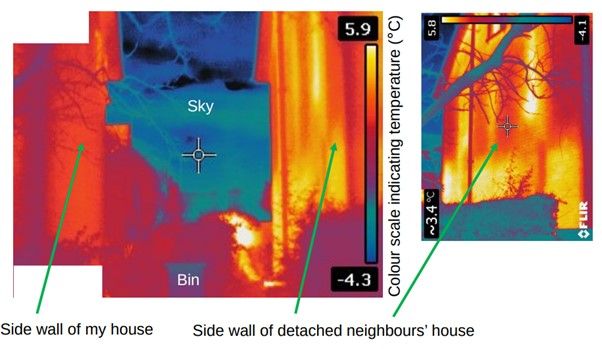Domestic energy efficiency - a case study
Sharing best practice in domestic energy reduction and home comfort
Jonathan Gregory is a climate scientist at the Met Office and the University of Reading. His home in Reading is a Pioneer SuperHome – one of about 250 in the UK which have been retrofitted to make them as energy efficient as possible. In this case study, we explore the work Jonathan has undertaken and the impact this has had.
Why retrofitting?
The UK Government target is to reach Net Zero by 2050, reducing greenhouse gas emissions in order to reduce the worst impacts of climate change. In the UK in 2022, CO2 emissions from residential properties made up 17% of all CO2 emissions1 mostly from central heating by burning gas. A further 8% of all CO2 emissions come from generating electricity for domestic users (around 30% of all electricity2). Reducing CO2 emissions due to residential use is therefore critical in helping the country meet Net Zero targets. Using less fossil fuel energy by retrofitting energy saving measures and/or using renewable sources of energy is the way to do this.
Insulating to reduce space heating needs
Heat leaks out of houses by conduction through the roof, walls, windows, doors and ground floor. Reducing the ‘leakiness’ means we need to supply less heat to keep the house warm. A layer of thermal insulation can make a big difference to the heat loss of a home, but ~33% of lofts in Great Britain have no loft insulation and ~29% of properties with a cavity wall have no cavity wall insulation. Moreover, there are about 9 million houses that have solid walls because they were constructed before cavity walls became common in the early 20th century. Of these old houses, 90% have no insulation of their external walls3.
Jonathan’s home is an old semi-detached house built with no cavity walls, so he took the step of adding an extra brick wall outside the side-wall to create a cavity between them, with a thick layer of insulation in it. “It looks no different from the outside, but the reduced heat loss can be seen in the thermal view of my house compared to my neighbours’,” explains Jonathan. “Other walls were also insulated internally, insulation was added underneath the floorboards on the ground floor, and double-glazed windows were fitted along with a new insulated and triple-glazed front door.”

Image description: The cooler temperatures shown in the thermal imaging of Jonathan’s house on the left of the image compared to the neighbours’ house on the right, indicate the improved heat retention of the building.
Renewable energy
There are various renewable energy sources which can be considered when retrofitting homes, and Jonathan has chosen to fit solar photovoltaic (PV) panels for electricity, and a solar thermal panel for hot water. “There’s only one solar thermal panel, but that’s enough for all of our hot water needs during the summer months”, explains Jonathan.
The electricity generated by the photovoltaic panels reduces the amount of electricity bought from the electricity company. When more is being generated than used, which happens during the day, especially in summer, the electricity company buys the excess. “I am planning to install a battery, so I can store some of what’s generated for use outside sunshine hours,” said Jonathan. Over a year, the PV panels generate about as much electricity as is used for everything in the house except the central heating.
Jonathan replaced the gas boiler in 2020 with an air source heat pump (ASHP), which runs on electricity and is 2-3 times more efficient than burning gas for heat. “For the ASHP, we didn’t need to make any other change to the central heat system, such as replacing radiators. I’m pleased that at last we’re not burning any fossil fuel on the premises!”

Image description: An array of solar photovoltaic panels and one solar thermal panel on Jonathan’s roof.
Cost and carbon savings
The exact savings to be realised from measures such as those taken by Jonathan will vary depending on the size of property, and the Energy Saving Trust has up to date estimates for different types of insulation and property size. For example, cavity wall insulation for a semi-detached house may cost around £2700, will result in savings of around £280 a year on energy bills and reduce household CO2 emissions by 650kg a year.
Grants are available towards the cost of some energy saving measures and details of the latest schemes can be found on the Government’s Energy Efficient Home website. These can make a notable difference to the initial outlay required and therefore the pay-back period.
Jonathan has been making improvements to his home for over 20 years and has kept track of his energy usage over that time. As is demonstrated in the chart below, the energy used in Jonathan’s home has dropped significantly as energy saving measures have been implemented, resulting in a reduction of more than 80% in the amount of energy it needs. Since this remaining requirement is electricity which he buys from a renewable provider, the CO2 emissions due to the house are now zero – a 100% reduction.

Image description: Chart showing the gas and electricity imported to the home, energy generated by renewable sources, and energy use between 1998 and 2022. The total kilowatt-hours (kWh) of energy used in the year from 1 September 2022 was about 15% of that used on average per year between 1998 and 2000.
“Older properties were not built to be energy efficient,” says Jonathan. “There are many ways to improve their energy efficiency which will save money and CO2. I described what I’ve done with my house, and why I did it, in a talk last year for the British Library, which you can watch on-demand if you’d like to learn more.”
1 Source: https://assets.publishing.service.gov.uk/media/6424b8b83d885d000fdade9b/2022_Provisional_emissions_statistics_report.pdf
2 Source: https://assets.publishing.service.gov.uk/media/64c23a300c8b960013d1b05e/DUKES_2023_Chapter_5.pdf
3 Source: https://assets.publishing.service.gov.uk/media/64230bbd3d885d000cdadd20/HEE_Stats_Detailed_Release_-_Mar_23.pdf


